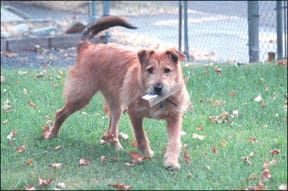[Updated July 19, 2017]
Your dog grabs your stuff and runs away either because she knows you’re going to take it from her and she doesn’t want you to, or she’s inviting you to join in her a fun game of “Catch me if you can.” In either case, chasing after her is usually the least effective way to get your stuff back. Besides the obvious “management, to prevent her access to your stuff,” and “exercise (mental and physical) to keep her happily otherwise occupied,” here are five suggestions that will maximize your chances of getting your precious thing(s) back quickly, relatively unscathed.
When your dog steals something, try these tricks:

1. Run the other way
Really. Chasing after your dog almost guarantees she will run away. If her motivation for stuff-grabbing is to get you to play, she may be just as happy to chase you. Let her chase you into a reasonably small space, close the door, and then employ Suggestion #3, 4, or 5 to convince her to give you your stuff back. (If her motivation is to get and keep stuff rather than get you to chase after her to play, this one probably won’t work. Go on to Suggestion #2.)
2. Quietly follow your dog
If your dog wants to keep your stuff rather than play with you, any noise and fury on your part will cement her intentions and make it infinitely harder to get the thing away from her. You risk triggering aggression in a dog who already guards, or teaching it to one who doesn’t yet. Be calm and cheerful. I know; it’s hard to be calm and cheerful when your dog has your valuable heirloom keepsake. Do it anyway. When the opportunity presents itself, engage in Suggestion #3 or 5, but carefully. Suggestion #4 may work, but is less successful when your dog’s motivation is keeping rather than playing. Because the dog in this scenario is likely to be guardy, any pressure on your part may cause her to hold onto the item more intensely, or even bite you. Don’t corner or trap her; that could increase the risk of aggression. If she takes the item into her crate, do not reach in to get it until you have successfully negotiated her out of her crate.
3. Trade for treats
Now that she’s not running away, your best chance at getting your thing back unshredded is to have your dog give it up willingly. If you try to grab it you’re likely to end up in a game of tug, and your stuff will suffer. To trade, simply convince your dog to drop your thing in exchange for something irresistible. Every room in my house has a container full of “something wonderfuls” just in case I need them. My favorites (and my dogs’) is Canz “Real Meat Treats.” I get them from dogcatsupply.com. They are top quality ingredients, moist and meaty, and need not be refrigerated.
If your dog won’t trade for a treat in your hand, drop some treats on the ground. When your things are safely back in your own possession, vow to train your dog to give up objects happily on cue.
4. Throw a toy for your dog fetch
If your dog is more into tennis balls or plush toys than treats, engage her in play with her toy to get her to let go of yours. Keep at least one very favorite toy on a shelf in every room. The sound of her squeaky toy, or the mere sight of her beloved ball or tug rope, is usually enough for a toy-fanatic to drop your possession so she can go after hers. After all, she just wanted to play in the first place. Be sure to play for a while, so she doesn’t get wise to your scheme.
5. Use diversion tactics
What else does your dog love to do? Go for a walk? Ride in the car? Eat dinner? Get the squirrel? If you have stock phrases you use with your dog that will trigger an immediate, wildly enthusiastic response, try one of those (you have to sound genuine!) to see if you can get her brain to switch gears. At the sound of an excited “Get in the car!” she may well drop your thing and head for the door. Of course, then you are obligated to take her for a ride. If you lie to your dog, sooner or later your karma will come back to bite you!
Pat Miller, CPDT-KA, CDBC, is WDJ’s Training Editor. Miller lives in Fairplay, Maryland, site of her Peaceable Paws training center. Pat is also author of several books on positive training.






